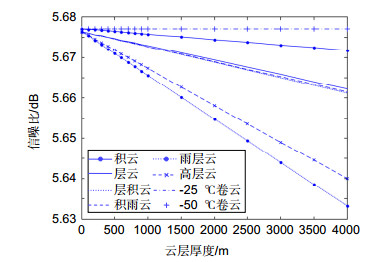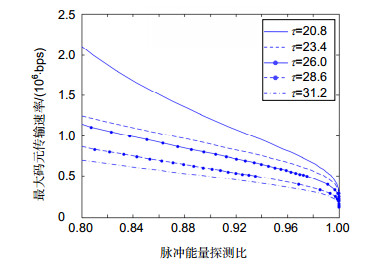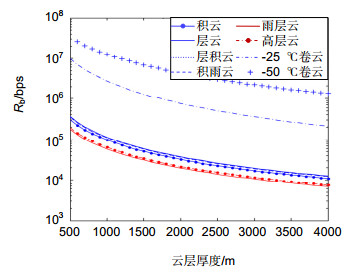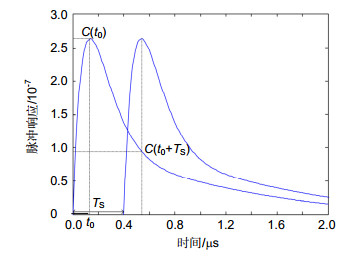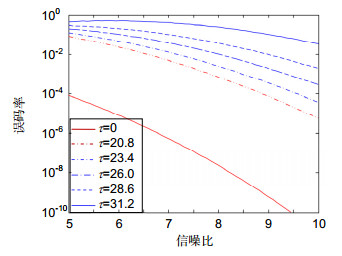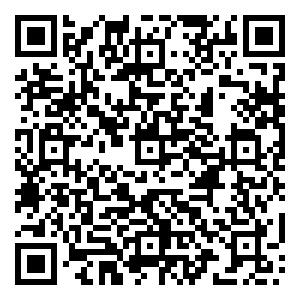Analysis of the effect of cloud thickness on the performance of blue-green laser communication
-
摘要:
针对机载激光发射器位于云层上方或云层中央时,云层的存在会降低激光通信性能的问题,仿真分析了不同类型的云层对激光能量衰减、信噪比、最大码元传输速率与误码率的影响。得到结论:云的存在主要造成激光能量衰减,影响最大传输速率与误码率,但对信噪比影响较小。链路余量大于18.9 dB的通信系统,链路上允许存在4 km的云层。云层对最大通信速率与误码率的影响主要是时间扩展造成码间串扰。卷云对通信性能几乎无影响;积云对通信性能的影响较大;层云、层积云和积雨云对通信性能的影响更大,但三种云的差异很小,可不作区分;高层云和雨层云对通信性能影响最大,其中雨层云的影响比高层云更大。
 Abstract:
Abstract:When the airborne laser transmitter is located above or in the center of the cloud, the cloud will reduce the laser communication performance. In order to solve this problem, the effects of different types of clouds on laser energy attenuation, signal-to-noise ratio (SNR), maximum symbol transmission rate and bit error rate are simulated and analyzed. It is concluded that the cloud mainly causes laser energy attenuation, which affects maximum transmission rate and bit error rate, but has little effect on SNR. For communication systems with link margin greater than 18.9 dB, 4 km cloud cover is allowed on the link. The effect of cloud on the maximum communication rate and bit error rate is mainly caused by inter-symbol crosstalk caused by time extension. Cirrus has little effect on communication performance, cumulus has a great impact on communication performance, and stratus, stratocumulus, and cumulonimbus have a greater influence on the communication performance, but the differences between the three types of clouds are small and could be not be distinguished. Altostratus cloud and nimbostratus have greatest influence on communication performance, of which nimbostratus has greater influence than altostratus cloud.
-

Overview: Using airborne wireless optical communication, if the laser transmitter located above or in the center of the cloud, the quality of communication on the receiving end will be severely degraded. Therefore, effective measures should be taken to improve communication performance. It is necessary to analyze the influence of clouds on the performance of wireless optical communication, which provides a theoretical basis for the rate adaptation and channel equalization design when there are clouds on the link.
In this paper, Vande Hulst formula is used to simulate the transmittance of blue-green laser passing through clouds, and calculate link margin and SNR. The monte carlo simulation method is used to simulate the waveform of the pulse passing through the thin clouds, and the waveform is fitted as a double gamma function. The relationship between the detection ratio of simulated pulse energy and the maximum symbol transmission rate is simulated. Stotts formula is used to calculate the time width of half power point, then estimate the maximum symbol transmission rate, and calculate the bit error rate in excess of maximum transmission rate.
It is concluded that cloud mainly causes laser energy attenuation, which affects maximum communication rate and bit error rate, but has little effect on SNR. Cirrus has little effect on communication performance, stratus, stratocumulus, and cumulonimbus have a great influence on the communication performance, but the differences between the three types of clouds are small and could be not be distinguished. Altostratus cloud and nimbostratus have great influence on communication performance, of which nimbostratus has greater influence than altostratus cloud.
From the perspective of laser energy attenuation, cloud plays a dominant role. For communication systems with link margin greater than 18.9 dB, 4 km cloud cover is allowed on the link. From the point of view of SNR, the influence of turbulence is still dominant, and the cloud thickness only reduces the SNR slightly, which is basically the same as that without cloud. From the perspective of maximum communication rate and bit error rate, the time expansion will be caused due to multi-path effect when the pulse passes through the cloud. The inter-symbol crosstalk will be caused when the communication rate is too high, so the communication rate will be limited. When the communication rate exceeds the maximum value, it will cause inter-code crosstalk, increase the bit error rate, and reduce the communication quality. The improved methods include the sending end rate adaptive and the receiving end channel equalization, which need to be further studied.
-

-
表 1 不同类型云的衰减系数
Table 1. Attenuation coefficients of different types of clouds
云层类型 积云 层云 层积云 积雨云 雨层云 高层云 -25℃卷云 -50℃卷云 衰减系数/m-1 0.0539 0.0418 0.045 0.044 0.128 0.108 0.000662 0.000072 表 2 双Gamma函数的拟合结果
Table 2. Fitting result of double Gamma function
系数 τ=20.8 τ=23.4 τ=26 τ=28.6 τ=31.2 k1 120.1 34.1 12.4 5.1 2.4 k2 1.9×107 1.9×107 1.1×107 0.8×107 0.7×107 k3 1.55 1.6 0.66 0.28 0.19 k4 3×106 3×106 2.4×106 1.8×106 1.6×106 -
[1] Bucher E A. Computer simulation of light pulse propagation for communication through thick clouds[J]. Applied Optics, 1973, 12(10): 2391–2400. doi: 10.1364/AO.12.002391
[2] Mooradian G C, Geller M. Temporal and angular spreading of blue-green pulses in clouds[J]. Applied Optics, 1982, 21(9): 1572–1577. doi: 10.1364/AO.21.001572
[3] 狄凌峰, 王沛, 鲁拥华, 等.近地大气532 nm激光散射的实验与计算[J].量子电子学报, 2005, 22(6): 960–964. doi: 10.3969/j.issn.1007-5461.2005.06.026
Di L F, Wang P, Lu Y H, et al. Experiment and calculation of 532nm laser scattering in the near ground atmosphere[J]. Chinese Journal of Quantum Electronics, 2005, 22(6): 960–964. doi: 10.3969/j.issn.1007-5461.2005.06.026
[4] Hess M, Koepke P, Schult I. Optical properties of aerosols and clouds: The software package OPAC[J]. Bulletin of the American Meteorological Society, 1998, 79(5): 831–844. doi: 10.1175/1520-0477(1998)079<0831:OPOAAC>2.0.CO;2
[5] 胡秀寒, 周田华, 朱小磊, 等.云对激光下行传输影响的仿真研究[J].红外, 2015, 36(2): 8–12. doi: 10.3969/j.issn.1672-8785.2015.02.002
Hu X H, Zhou T H, Zhu X L, et al. Simulation of downward laser pulse propagation through clouds[J]. Infrared, 2015, 36(2): 8–12. doi: 10.3969/j.issn.1672-8785.2015.02.002
[6] Arnon S, Sadot D, Kopeika N S. Analysis of optical pulse distortion through clouds for satellite to earth adaptive optical communication[J]. Journal of Modern Optics, 1994, 41(8): 1591–1605. doi: 10.1080/09500349414552431
[7] Arnon S, Kopeika N S. Adaptive optical transmitter and receiver for space communication through thin clouds[J]. Applied Optics, 1997, 36(9): 1987–1993. doi: 10.1364/AO.36.001987
[8] 刘建斌, 李海.基于Mie理论的四种典型水云的光散射计算[J].广西大学学报(自然科学版), 2009, 34(6): 863–867. doi: 10.3969/j.issn.1001-7445.2009.06.030
Liu J B, Li H. Calculation of light scattering on water cloud particles by using Mie's theory[J]. Journal of Guangxi University (Natural Science Edition), 2009, 34(6): 863–867. doi: 10.3969/j.issn.1001-7445.2009.06.030
[9] 陈纯毅, 杨华民, 姜会林, 等.云层信道光通信链路误码率及性能改善途径分析[J].系统仿真学报, 2009, 21(5): 1245–1248. http://d.old.wanfangdata.com.cn/Periodical/xtfzxb200905007
Chen C Y, Yang H M, Jiang H L, et al. Analysis of bit-error-rate and performance enhancement ways for optical communication link through cloud channel[J]. Journal of System Simulation, 2009, 21(5): 1245–1248. http://d.old.wanfangdata.com.cn/Periodical/xtfzxb200905007
[10] 柯熙政, 席晓莉.无线激光通信概论[M].北京:北京邮电大学出版社, 2004.
Ke X Z, Xi X L. Introduction to Wireless Laser Communication[M]. Beijing: Beijing University of Posts and Telecommunications Press, 2004.
[11] 杨虹, 杨小丽.激光在云层信道中传输的蒙特卡罗模拟[J].激光杂志, 2008, 29(2): 44–46. doi: 10.3969/j.issn.0253-2743.2008.02.019
Yang H, Yang X L. Monte carlo simulation of light pulse propagation through clouds[J]. Laser Journal, 2008, 29(2): 44–46. doi: 10.3969/j.issn.0253-2743.2008.02.019
[12] 柯善勇.空间激光通信中的信道建模研究[D].武汉: 华中科技大学, 2007.
Ke S Y. A thesis submitted in fully fulfillment of the requirement for the degree of master of engineering[D]. Wuhan: Huazhong University of Science and Technology, 2007.
[13] Winker D M, Poole L R. Monte-Carlo calculations of cloud returns for ground-based and space-based LIDARS[J]. Applied Physics B, 1995, 60(4): 341–344. doi: 10.1007/BF01082269
[14] 李景镇.光学手册[M].西安:陕西科学技术出版社, 1986: 859–862.
Li J Z. Optical Manual[M]. Xi'an: Shaanxi Science and Technology Press, 1986: 859–862.
[15] 刘敏, 刘锡国, 牟京燕, 等.无线光通信光功率衰减模型分析[J].红外与激光工程, 2012, 41(8): 2136–2140. doi: 10.3969/j.issn.1007-2276.2012.08.032
Liu M, Liu X G, Mou J Y, et al. Analysis of power attenuation model for wireless optical communication[J]. Infrared and Laser Engineering, 2012, 41(8): 2136–2140. doi: 10.3969/j.issn.1007-2276.2012.08.032
[16] 李玉权, 朱勇, 王江平.光通信原理与技术[M].北京:科学出版社, 2006: 321–323.
Li Y Q, Zhu Y, Wang J P. Principle and technology of optical communication[M]. Beijing: Science Press, 2006: 321–323.
[17] Stotts L B. Closed form expression for optical pulse broadening in multiple-scattering media[J]. Applied Optics, 1978, 17(4): 504–505. doi: 10.1364/AO.17.000504
[18] Lee S, Hamzeh B, Kavehrad M. Airborne laser communications and performance enhancement by equalization[C]//Lasers & Applications in Science & Engineering. San Jose, California, United States: SPIE, 2006.
-


 E-mail Alert
E-mail Alert RSS
RSS
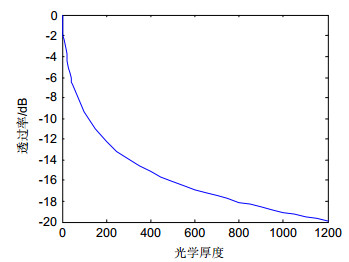
 下载:
下载:

